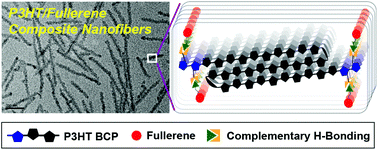Nano-structuring polymer/fullerene composites through the interplay of conjugated polymer crystallization, block copolymer self-assembly and complementary hydrogen bonding interactions†
Abstract
We describe a facile strategy of precisely nano-structuring conjugated polymer (CP)/fullerene composites for organic photovoltaics (OPVs). By building in strong complementary hydrogen bonding interactions between CP nanofibers (NFs) and fullerene derivatives, well-defined and stable supramolecular polymer/fullerene composite NFs are obtained. Specifically, a conjugated block copolymer having poly(3-hexylthiophene) (P3HT) backbone selectively functionalized with polar isoorotic acid moieties, P3HT-b-P3IOAT, and a diaminopyridine tethered fullerene derivative, PCBP, are used as the building blocks. Self-assembly of P3HT-b-P3IOAT in mixed solvents leads to core–shell micelle-like NFs having IOA groups preferentially located on the periphery of the P3HT NF core, onto which PCBP molecules are subsequently attached non-covalently. Formation of such complex structures are studied in detail and confirmed by NMR spectroscopy, absorption spectroscopy, transmission electron microscopy, atomic force microscopy, and X-ray scattering measurements. Application of these composite NFs in OPV devices is investigated and evaluated, which shows close correlations between device performance and morphology controllability.


 Please wait while we load your content...
Please wait while we load your content...